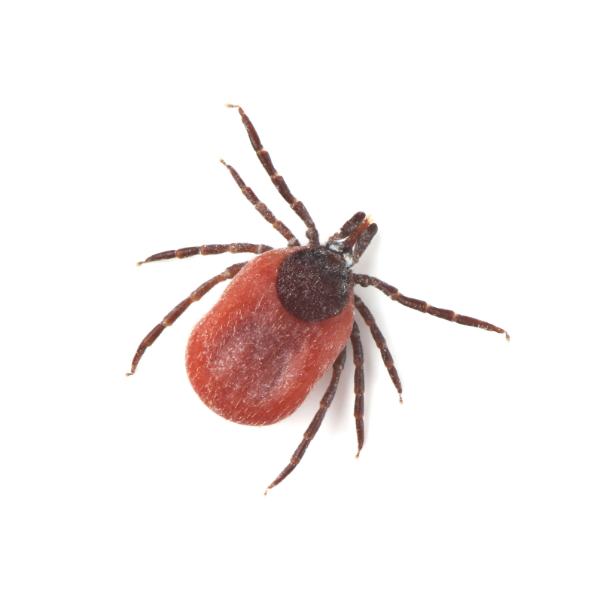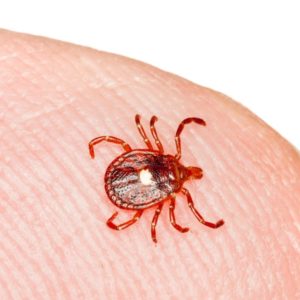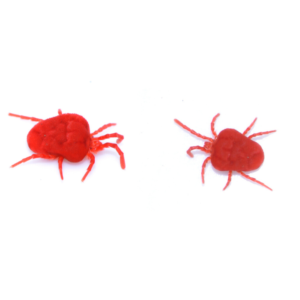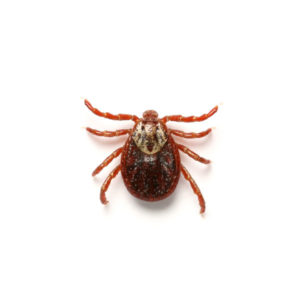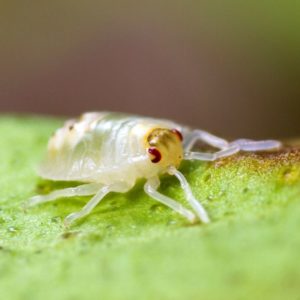Deer Tick Identification
What Do Deer Ticks Look Like?
Deer ticks, also known as black-legged ticks (Ixodes scapularis), are small arachnids with a reddish-brown to black body and legs. Adults have a flat, oval shape before feeding and become engorged and round when fully fed. They are about the size of a sesame seed, while nymphs are smaller. Deer ticks have a distinct lack of white markings on their dorsal shield.
Signs of a Deer Tick Infestation
Signs of a deer tick infestation include finding ticks on pets or humans, particularly in areas with dense vegetation or wooded habitats where they thrive. These ticks may attach to hosts and feed on their blood, potentially transmitting diseases such as Lyme disease. Regularly checking pets and yourself for ticks after outdoor activities can help detect infestations early.
Habitat, Diet, Life Cycle & Bites
Where Do Deer Ticks Live?
Deer ticks live in shady, moist areas at ground level, clinging to tall grass, brush, and shrubs, usually no more than 18-24 inches off the ground. Ticks also live in lawns and gardens, especially at the edges of woods and around old stone walls. Deer ticks will not be found out in the middle of your lawn, preferring yards that border wooded areas. Ticks also live in ornamental plantings and gardens, or any environment that offers available shade, and high humidity.
Diet of a Deer Tick
Deer ticks, in all life stages, feed on the blood of various hosts, including mammals, birds, and sometimes reptiles. They use their specialized mouthparts to pierce the skin of their hosts and consume blood for nourishment. This blood meal is essential for their growth, development, and reproduction, making them obligate parasites throughout their life cycle.
Cycle of a Deer Tick
The life cycle of a deer tick consists of four stages: egg, larva, nymph, and adult. Eggs hatch into larvae, which seek hosts like small mammals or birds. After feeding, larvae molt into nymphs, which also seek hosts, often larger mammals. After feeding again, nymphs molt into adults. Adult ticks then seek larger hosts, including deer and sometimes humans, to feed and mate.
Do Deer Ticks Bite?
Deer ticks bite, and the greatest risk of being bitten occurs during spring, summer, and fall. However, adult ticks may be out searching for a host any time winter temperatures are above freezing. Stages most likely to bite humans are nymphs and adult females. To avoid being bitten, apply an insect repellent containing an EPA-registered ingredient, such as DEET. Also, consider wearing long-sleeved shirts and pants, preferably light-colored so ticks will be easy to detect, and tuck pants into socks.
Are Deer Ticks Dangerous?
Deer ticks, also known as blacklegged ticks, are the primary carrier of Lyme disease in the United States. Widely distributed across the eastern U.S., they are predominantly found in humid, deciduous forests. Their distribution relies greatly on the distribution of their reproductive host, the white-tailed deer. Both nymph and adult stages transmit diseases such as Lyme disease, Babesiosis, and Anaplasmosis. In 2018, there were approximately 23,558 confirmed cases of Lyme disease, making it the most common vector-borne disease in the United States.
How to Get Rid of Deer Ticks
To protect against deer ticks – wear long clothing and use insect repellents containing DEET or permethrin when outdoors. After outdoor activities, promptly check yourself and pets for ticks and remove any attached ticks carefully. Trim vegetation around the home to reduce tick habitat and consider treating outdoor areas.
If you are dealing with deer ticks, it’s important to always enlist the help of a professional tick & mite control expert.
Deer Tick Prevention Tips
To prevent deer tick bites, wear long sleeves, pants, and closed shoes when outdoors, especially in wooded or grassy areas. After outdoor activities, promptly check yourself and pets for ticks, and remove any attached ticks carefully to reduce the risk of disease transmission.
Read our top tips on how to prevent fleas and ticks.
Need help with Deer Ticks control?
FAQs
What happens if you get a deer tick?
If bitten by a deer tick, consult with a medical professional and monitor for symptoms of tick-borne illnesses such as Lyme disease. Remove the tick promptly and carefully, and consult a medical professional if symptoms like rash, fever, or flu-like symptoms develop.
Do deer ticks always carry Lyme disease?
No, deer ticks do not always carry Lyme disease. While they are the primary vector for Lyme disease, not all deer ticks are infected. The risk of contracting Lyme disease from a tick bite varies depending on geographic location and other factors.
How can you tell if it’s a deer tick?
You can identify a deer tick by its reddish-brown to black color, eight legs, and lack of white markings on its dorsal shield. Deer ticks are also typically smaller than other common tick species, such as dog ticks.

